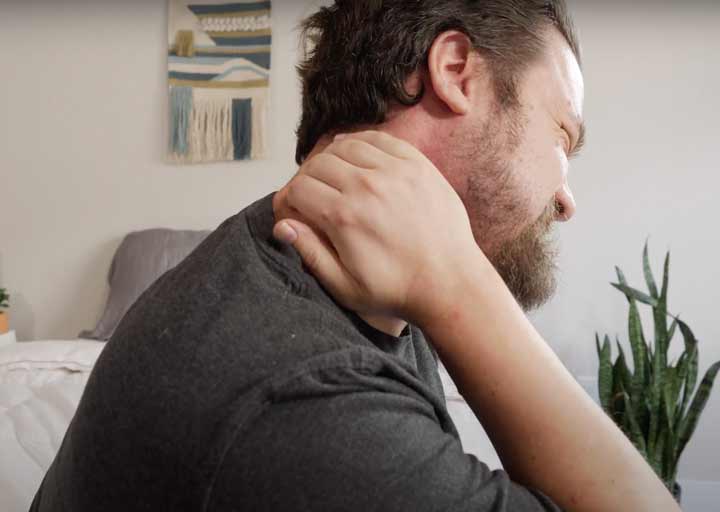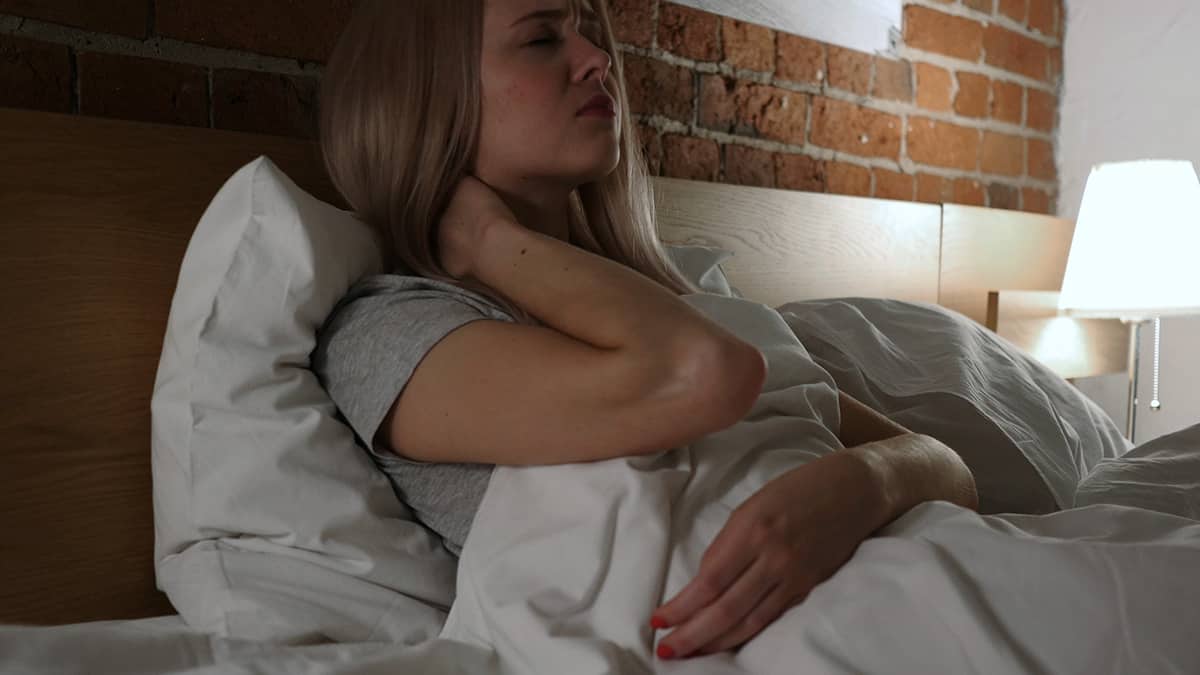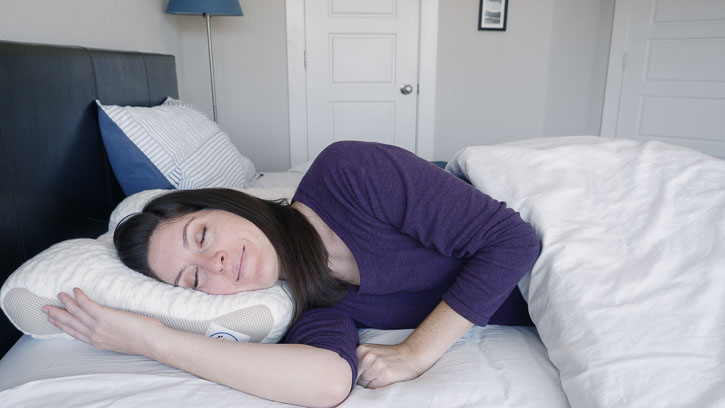If you’re waking up with neck pain in the morning, you know how disruptive it can be to your day. Whether it’s a dull ache, a shooting pain, or a loss of mobility, neck pain can interfere with your ability to work, drive, and perform other essential daily activities.
Discover some of the more common causes of neck pain and how you can get rid of it fast.
What is Neck Pain?
Neck pain is known as cervicalgia, and it affects the cervical spine located beneath your head. Neck pain can be acute, lasting for days or even weeks at a time, or chronic, lasting three months or longer.
Some people experience neck pain as a dull persistent ache, and others as sharp, shooting, or stabbing pain. It can also be accompanied by other symptoms, including headaches, numbness or tingling in your arms or shoulders, or the inability to turn or tilt your neck and head.
Neck pain affects as many as 10-20% of adults and becomes more common as you age.

Types of Neck Pain
There are varying types of neck pain, each with their own unique causes and symptoms. Some of the more common types of neck pain include:
Muscle Strain
Poor posture, repetitive motion, or whiplash from a collision or fall can all result in muscle strain, or neck strain. You have 20 different muscles in your neck, and when these muscles overexert or over-stretch, it can cause small tears and inflammation known as neck strain or muscle strain.
Symptoms of neck strain can include:
- Pain in the neck and nearby regions (such as head and shoulders)
- Aching, throbbing, or sharp pain that worsens with movement
- Stiff neck
- Muscle spasms
Pinched Nerve in Neck
Your nerves are a communication pathway sending messages back and forth between your brain, muscles, and skin. When a nerve gets constricted (pinched) or inflamed, it can start sending pain signals to your brain. Generally, pinched nerves in your neck are caused by a spinal vertebrae squeezing a nerve, usually as a result of injury.
Symptoms of a pinched neck can include:
- Sharp pain in your neck, back, shoulder, arms, or hand
- Tingling or numbness in the neck or upper extremities
- Symptoms that worsen when you turn your head, sneeze, or cough
Rheumatoid Arthritis
Rheumatoid arthritis is a chronic inflammatory autoimmune disorder affecting many bodily systems, including your joints. Rheumatoid arthritis (RA) usually starts off affecting small joints, such as those in your fingers and hands, but can progress to affect other joints, like those in your neck. RA is caused by inflammation of the joints.
Symptoms of rheumatoid arthritis in the neck can include:
- Neck pain (the severity can vary from person to person)
- Joint swelling and stiffness
- Headaches that mimic a migraine or cluster headache known as cervicogenic headaches
Herniated Disc
Cervical discs are the cushions or padding in between your cervical vertebrae. They act as shock absorbers, helping your neck and head enjoy a full range of motion. If the outer layer of that cushion tears, the soft inner center can push out in a condition known as a herniated disc.
Symptoms of a herniated disc can include:
- Pain in your shoulder or arm
- Pain described as sharp, shooting, or burning
- Numbness, tingling, or weakness in your upper extremities
Spinal Stenosis
Spinal stenosis occurs when spaces between the spine narrow and create pressure. It can happen as a result of injury or in people born with a narrow spinal canal. Aging, injury, and other conditions (such as arthritis) can also contribute to spinal stenosis.
Symptoms of spinal stenosis can include:
- Neck pain
- Numbness or tingling that radiates down the arms into the hands
- Weakness in the upper extremities

What Causes Neck Pain After Sleeping?
If you rolled out of bed one morning with a stiff or painful neck, it may have more to do with how you’re sleeping—and what you’re sleeping on—than one of the above-mentioned medical causes of neck pain.
Improper Support
When you’re laying down to sleep at night, your spine should be supported all the way from your nose to your toes. Imagine a string that runs from the top of your head to the bottom of your feet. Regardless of whether you’re lying on your back or side, that string should be straight, not dipping down at your head, neck, or hips.
Your Mattress
Choosing a mattress that is firm enough to support your body while still soft enough to feel comfortable is a big step towards banishing sleep-related neck pain. A good rule of thumb when choosing a mattress firmness is that softer mattresses are usually good for side sleepers, while firmer mattresses are better for back and stomach sleepers. Other factors such as your body weight, size, age, and injuries can all influence the type of mattress that is most comfortable and supportive for you.
When you’re looking for a mattress to prevent neck pain, have another person on hand who can look at the alignment of your body. If you’re sinking too far into the mattress at your hips or shoulders, that mattress may not be the right fit for you. If your spine is aligned nice and straight, you’re probably on your way to a pain-free night.
Your Pillow
Your pillow can also be one of the factors contributing to neck pain after sleeping. Many of the pillows you can find in general retail stores or big box stores look nice when they’re piled high on a bed but aren’t designed to provide good support for your spine.
Generally speaking, side sleepers will need a bit more height from their pillows compared to back sleepers. If you sleep on your stomach, you will want a pillow with very little height at all.
Regardless of your preferred sleeping position, your pillow should support your head so that your spine lies in a straight line. If you’re not sure if your pillow is too high or too low, ask someone to assess your sleep posture. Taking a photo can also help, so you can identify if your head is rising up or dropping down when it is settled on your pillow.

Poor Sleep Posture
The position you sleep in could also be having an impact on how good your neck and back feel when you wake up in the morning.
You can also use pillows to support a healthy sleep posture. Some people place a pillow underneath or in-between their knees to help align their spines and hips when sleeping.
There is no one “best” position for sleeping; however, stomach sleepers do tend to have more neck problems than side and back sleepers. If your preferred sleep position is contributing to neck pain, you can train yourself to sleep in a different position.
Headaches or Migraines
If your pillow or mattress is causing neck strain and pain, it can also contribute to headaches. If your pillow isn’t supporting your neck or spine, you could be suffering from a number of pillow-related headaches, including migraines.
Again, be sure to use the right pillow for your preferred sleeping position to avoid headaches from neck strain.
- Stomach sleepers require the thinnest pillow height
- Back sleepers require a medium pillow height
- Side sleepers require the tallest pillow height
Avoid piling multiple pillows up as you sleep. When you find the right pillow, you’ll only need one — it will support your neck and spine and keep you in alignment as you sleep.
How to Sleep with Neck Pain
If you’ve spent the day suffering from neck pain, a restorative night’s sleep may be just what you need to start feeling a bit better. But how do you get to sleep if you’ve got pain in your neck? In addition to ensuring your pillow is supporting a proper alignment, the following tips will help you sleep with neck pain.
Best Sleeping Positions for Neck Pain
According to Harvard Health, the two best sleeping positions for neck pain are side sleeping and back sleeping.
The type of pain you’re experiencing may help you uncover the most comfortable position to sleep in when your neck hurts. For example, if you are experiencing neck pain on one side of your body, along with pain, tingling, or numbness in your shoulder, arm, and hand on that side, you may want to avoid side sleeping. Instead, try to settle into a back sleeping position to alleviate pain on one side or the other.
If you have pain in the upper or lower neck, you may find that back or side sleeping helps. What’s most important here is that you have a supportive pillow that is keeping your spine in the proper alignment. Follow your pillow’s lead for upper or lower neck pain. Depending on the pillow, it may offer better alignment on your back or side.
Regardless of where your pain is located, avoid sleeping on your stomach if you have neck pain.

How to Get Rid of Neck Pain Fast
Banishing neck pain fast could be the key to getting back to your daily activities (and a good night’s sleep). Here are a few ways you can start feeling better fast when you’ve woken up with neck pain.
Use a Cold Pack
Applying cold to your neck, such as a cold pack or ice pack, can help reduce swelling and inflammation. That’s why cold therapy is highly recommended when you are suffering from neck pain. If you’re using a cold pack, wrap it in a cloth or paper towel and apply it to the affected area for 15-20 minutes, and then take an hour or two rest period to allow your skin to recover. You can repeat this process as often as needed.
Try a Heating Pad
When heat is applied to your sore neck, it can help relax your muscles and bring more healing blood flow to the area. Just like an ice pack, you’ll want to apply heat to the affected area for 15-20 minutes and then take a break to give your skin plenty of time to recover.
You can also try alternating hot and cold treatments to simultaneously relax your muscles and reduce swelling and inflammation.
Gently Massage Your Neck
Massage therapy has been shown to provide temporary relief from neck pain. Research has shown that massage can be an effective tool for reducing pain. It works by increasing blood flow to areas (similar to heat therapy) and relaxing muscles and nerves.
When massaging your neck for pain relief, be gentle. Apply a medium amount of pressure and avoid attacking the problem with a massage gun or other high-pressure method that may cause more inflammation or tears in the muscles.
Take Pain Relievers
Pain relievers and anti-inflammatories can also help dull the pain from neck pain after sleeping.
- Homeopathic pain relievers, such as arnica, may help reduce pain, swelling, and soreness. Homeopathic remedies are generally well-tolerated, fast-acting, and have few reported side effects.
- Over-the-counter (OTC) pain relievers can either work as anti-inflammatories (NSAIDs such as aspirin or ibuprofen) that prevent swelling or as analgesics (like acetaminophen) that work to dull pain sensations in the brain and central nervous system. OTC pain medications are generally well-tolerated but have known side effects.
- Prescription pain medications such as opioids and muscle relaxers are available only from a healthcare provider. Prescription pain relievers can provide stronger relief but come with a much greater risk for potentially serious side effects, including substance abuse.
Get a New Pillow
If your pillow fails to properly support your neck or spine, it’s time to get a new pillow. This could be the easiest and quickest way to recover from neck pain from sleeping.
When shopping for the best pillow for neck pain, it’s important to keep in mind your preferred sleeping position. Remember that stomach sleepers need the thinnest pillows, back sleepers need a medium-height pillow, and side sleepers need more height.
Your body size will also determine the right pillow. Getting a matching pair of pillows may look nice on your bed, but it’s rare for two sleeping partners to be the exact same size and prefer the exact same sleeping position. Save the matching pillows for decorative purposes, and be sure that you—and your sleeping partner—both have the right pillows for your individual body size and sleeping style.
Exercises to Relieve Neck Pain
Gently stretching your neck can also help relieve neck pain. As with a neck massage, neck exercises are most effective when done gently. Don’t try to punish your neck into submission; overdoing it could cause more inflammation, muscle tears, and soreness if you come in too rough or aggressively.
Neck Rotation
- Keep your chin level with the ground as you rotate your head gently from side to side.
- Keep your motions small and move slowly.
- Don’t let your chin drop to your chest.
- Repeat 10x times.
Ear to Shoulder Touches
- Begin in a comfortable seated position.
- Relax your shoulders down away from your ears.
- Gently tilt your right ear to your right shoulder.
- Lightly place your right hand on your head to help ease into the stretch.
- Hold for ten seconds as you breathe.
- Repeat on the left side.
Head Nods
- Begin in a comfortable seated position.
- Place your finger on the front of your chin.
- Drop your chin slowly, pulling it in and gently away from your finger.
- Keep your eyes focused forward: don’t drop your head or look down.
- Return to your starting position.
- Repeat 10x.
Shoulder Rolls
- Seated or standing, shrug your shoulders up towards your ears.
- Squeeze your shoulder blades together and picture them moving down your back.
- Slowly release and move your shoulder blades back up.
- Let your upper back round as you return to your starting position.
- Repeat 10x.
FAQs
What’s the best way to sleep with neck pain?
The best way to sleep with neck pain is on your side or back. Be sure that your spine is fully supported and aligned and that your pillow is the right height to protect your alignment. You may need to experiment to find a position that feels good when your neck is in pain. Generally speaking, sleeping on your stomach is the worst position for your neck.
What’s the best pillow for neck pain?
The best pillow for neck pain is one that properly aligns your spine when you are in your preferred sleeping position. If you are a back sleeper, you will likely want a medium-height pillow, and stomach sleepers may require a slightly taller pillow.
Does sleeping without a pillow help with neck pain?
Sometimes it may feel good to sleep without a pillow if you have neck pain, particularly if you are a stomach sleeper or if you’ve been using a pillow that’s too tall for your body size and preferred sleeping position. While you can ditch your pillow, you may find that adjusting your pillow height may bring equal relief as sleeping without one.
Can sleeping with too many pillows cause neck pain?
Sleeping with too many pillows can definitely contribute to neck pain. You really only need one pillow for a good night’s sleep. If you have to stack multiple pillows on top of one another, it is a good sign that you don’t have the perfect pillow for your body size and preferred sleeping position.

